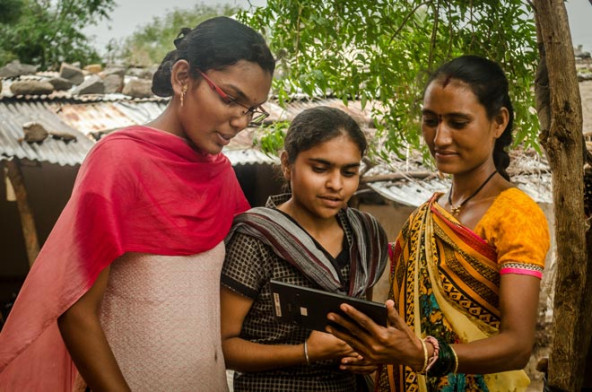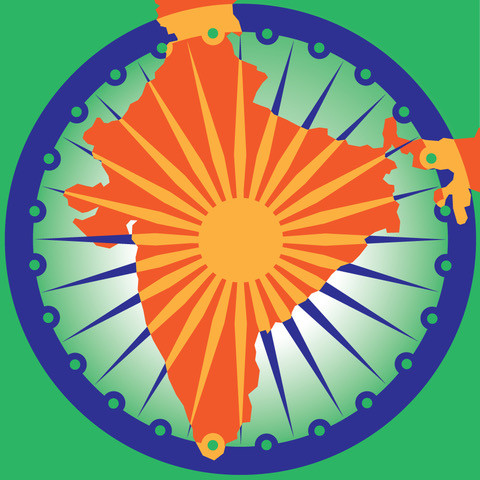 Women who are "Skill Sakhis" provide information about job training and convince girls to take on roles traditionally held by men. A Sakhi, right, shares a video of women performing their jobs with teenagers in the district of Aurangabad in Maharashtra, India, in July 2016. (Photo by Soham Sil)
Women who are "Skill Sakhis" provide information about job training and convince girls to take on roles traditionally held by men. A Sakhi, right, shares a video of women performing their jobs with teenagers in the district of Aurangabad in Maharashtra, India, in July 2016. (Photo by Soham Sil)
In the past decade in India, more women have enrolled in higher education, but they made up only 24 percent of the country's workforce from 2015 to 2016, down from 36 percent from 2005 to 2006.
Several factors have contributed to the decline, but restrictive social norms have played the most prominent role. Indian women have traditionally been physically and economically isolated, with roughly 80 percent of them being disallowed from visiting even a local health center without permission from their husbands or other family members. These obstacles make it harder for women to discover and take new jobs. And even if they do obtain employment, they faced continued pressure from their families to abandon their jobs, get married if they are single, and stay at home.

For the many Indian women who find themselves in these isolating circumstances, internet-enabled technologies can offer a way out by connecting them to the information and social networks they need to start and excel in their careers.
At Pratham Education Foundation, we have used everything from Raspberry Pis—an inexpensive computer the size of a credit card—to the messaging service WhatsApp to support our vocational training for young women who primarily come from rural, often tribal areas in India to take up jobs in cities.
Such internet-connected technologies have played critical roles in a few important elements of our recipe for success: awareness, role models, strong peer groups, and ongoing support.
Making TVs Smart
In the Indian state of Maharashtra, we worked in roughly 1,000 villages to create cadres of women called "Skill Sakhis," who were tasked with providing information about vocational training opportunities to locals and convincing girls that they could take on roles traditionally held by men. We helped the Sakhis accomplish this by giving them Raspberry Pis, low-cost devices that they could plug into televisions, turning them into smart, internet-connected tools that allowed access to Pratham's training videos and other content.
We eventually had 15,000 Sakhis across these villages organizing daily meet-ups of women. Their uses of the smart TVs at the convenings were varied. Attendees watched movies and cooking shows. But they also saw videos about the lives of working women from around their villages, and used the TVs to learn new skills, such as searching the internet or making a CV. Most importantly, they accessed information about vocational training and higher education courses they could apply to in their region.
We observed that the formation of these groups played a crucial role in women's efforts to handle familial pressure to conform to social norms. The women would reach out to all of their different families as a group when trying to get approval to pursue education and job opportunities, also indicating that they would undertake the opportunities together. Presenting their ambitions as something they would do as a collective provided comfort to concerned family members. It also gave the different families a chance to confer with each other and elect one person among them—usually a man—to travel to and inspect job or education centers.
Within a year of launching the program, the number of women joining vocational training courses doubled. There were other interesting effects: the creation of demand for electrician courses after the video of a female electrician gained traction; the launch of a woman-run car repair shop; and women starting micro-enterprises based in their homes.
These successes are of course inspiring. But to maintain a continuous flow of rural women into India's workforce, it is not enough to just ease barriers to entry. We also need to help women stay in their jobs once they have them.
Network Effect
Over the years, we have seen almost 75 percent of the women returning to their rural homes within one week of being placed in jobs after training. It's not surprising. Many of them face the pressure of being not just the first working woman in their families, but the first person in their family at all to start a career.
To help women stick with their job journey, we formed a network of Pratham alumni called "PAL." Women who join PAL can check in regularly with other more experienced members who are designated "buddies," or women who have already gone through many of the challenges facing newcomers. There was also a phone number to call for advice. Additionally, the online messaging service WhatsApp became a critical way for members of PAL support groups to stay in touch with one another.
Sonu, a 23-year-old hospitality employee and first working woman from her village, called the WhatsApp groups "our own underground LinkedIn network" that provided critical information about navigating human resources departments, arranging time off, and new job openings.
It has been two years since we started PAL. It has had a significant impact: Today, more than 80 percent of women who have gone through our programs are still working three months after starting their jobs.
Cheap Connectivity
The common thread amid Pratham's programs is the importance of connecting women to information and to one another through the internet. Raspberry Pis are great, but cellphones—which women in our programs already use to call one another and connect via WhatsApp—offer an ubiquitous, easy, and increasingly affordable way to deliver this connectivity.
There's also plenty of room for improvement: Only 38 percent of Indian women own the devices, with notable differences in ownership between urban, rural, poor, and wealthier women. And even when women own cellphones, they tend to use them for basic operations—calling and texting.
A number of organizations have demonstrated the power of internet connectivity to effect change in India. Microsoft's Project ReWeave included the launch of an ecommerce platform for handloom weavers. The Self-Employed Women’s Association (SEWA) has worked on a digital platform and, through one of its offshoot organizations, used WhatsApp to connect goods producers with buyers.
If we can get more women using internet-enabled cellphones in more ways—to watch training videos, form social networks, leverage tools like WhatsApp, and perform research, for example—then even more women could not only get jobs, but also stick with them.
It's a colossal task, but one we must undertake. Failure to do so will mean leaving Indian women further and further behind as digital technologies continue to reshape our economy and culture.
Support SSIR’s coverage of cross-sector solutions to global challenges.
Help us further the reach of innovative ideas. Donate today.
Read more stories by Medha Uniyal.

